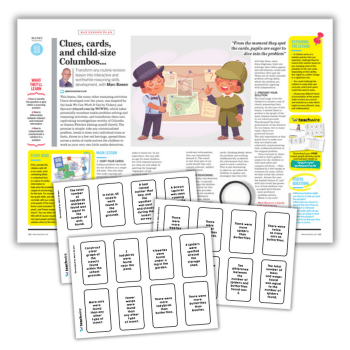Boost Maths Skills by Creating a Culture of Celebrating Mistakes

Making mistakes and getting questions wrong is a really efficient way to get pupils using technical maths vocabulary every lesson, and the cognitive pay-off is massive, says Ashley Booth…

- by Ashley Booth
- Year 6 teacher and AHT Visit website

Fluency into reasoning into problem solving: the bare bones of a decent maths lesson structure. Hit them with a few sums, get them to reason on the same objective and then solve a problem using what they’ve learnt. Brilliant.
Except a week, or sometimes even a day, later, they go back to the fluency part and can’t do it all over again.
There can be a multitude of reasons why this happens, but mostly it’s that inadequate practice has meant the learning hasn’t been committed to the long-term memory.
There’s a fear that pages of calculations show a lack of depth, which is true in a way, but there’s nothing wrong with a page of calculations if you break it up early with reasoning.
For me, one of the most effective ways to do this is to present the children with a wrong answer and ask them to pick apart why it isn’t correct.
For example, if you are teaching children to add fractions with the same denominator, you might give them five calculations and see how they get on. They will probably follow your modelled and worked examples pretty well and most will get them all right. Great.
Therein lies the temptation to move on really quickly to the next thing. What can be more effective here is to give them a question such as this: ‘Omar does 3/8 + 2/8. He gets the answer 5/16. What went wrong?’ The children now have to become deeply analytical about where Omar made a mistake.
It’s obvious to us, as adults, that Omar shouldn’t have added the two denominators together, but we need to see a depth of understanding from the children. They need to be able to explain not only where Omar went wrong, but why that isn’t correct. There’s an opportunity to really dig deep here.
A child will probably provide you with the answer, ‘Omar went wrong by adding the denominators together. The answer is 5/8’. Nothing wrong with that, but you’re in the market for immediate extension and deepening.
Say: “OK, great. You’re 80% of the way there, but can you now tell me why you don’t add the denominators together?”
If they can, brilliant; if they can’t, it’s likely they’re not the only one, so it’s a fantastic opportunity to bring the class back together and fill in the gap with a quick bit of teaching.
It’s also a really efficient way to get pupils using technical maths vocabulary every lesson.
Try saying, “When you’re doing today’s ‘what went wrong’ question, if you don’t use the words ‘numerator’ and ‘denominator’, your answer won’t be deeply explained enough.”
This enforcement of non-negotiable vocabulary means that those who still aren’t fully secure with what they mean will have to ask you about it, and you can quickly plug a gap.
After this, when children return to more fluency questions in the same lesson, or later on in the year, they should be more confident about doing it because they will have embedded in their mind where and why it can go wrong.
Once this culture of identifying misconceptions and mistakes is embedded, you can start to use it within the children’s own work, without them feeling ashamed or embarrassed.
If you’re circling the classroom and notice Ellen has got something wrong, stick the work on the visualiser and ask the class what they think.
The beauty of this approach is that the children do not need to publicly tell Ellen what mistake she has made.
Instead, everyone can silently reflect, then Ellen can tell you herself, calling on the expertise of her peers if she doesn’t know.
When the children really get the hang of this approach, it’s brilliant to see some of the more confident mathematicians constructing their own ‘what went wrong’ questions.
You know the type of child: the one that may as well bypass the fluency altogether.
Give them the fluency questions anyway and then see if they can demonstrate a deeper level of understanding by constructing a question addressing misconceptions in the same way that you would. The cognitive pay-off will be massive.
In conclusion, we want our children to celebrate errors and realise that they’re a vital part of learning. By bringing them up early and addressing them before they’ve even happened, we can minimise ‘foolish’ mistakes and ensure that children only struggle when the difficulty is really cranked up.
Ashley Booth is a Y6 teacher in Toxteth, Liverpool. Find him on his website at theteachingbooth.wordpress.com and follow him on Twitter at @mrboothy6.










